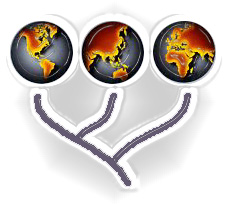
. |
.
Biogeographic Theory and
Analysis
Presented by: Dr. Jorge Crisci, Museo de La
Plata, Argentina
at University of Nebraska, Lincoln
May 13-17, 2002
|
| . |
"The definition of biogeography may be simple–the
study of the geographical distributions of organisms–but this simplicity
hides the great complexity of the subject. Biogeography transcends classical
subject areas, it involves a range of scientific disciplines that includes
geography, geology and biology. No one who studies biogeography can fail
to be impressed, or perplexed, by the diversity of approaches to the
subject."
–J.V. Crisci. 2001. The voice of
historical biogeography. Journal of Biogeography 28:157-168.

|
|
| . |
|
| |
|
As Dr.
Jorge Crisci so aptly stated in his 2001 keynote paper in
the Journal of Biogeography, the study of biogeography is in
the midst of an extraordinary revolution. In part, this revolution
is due to breakthroughs in computer technology that allow us
to interpret distributional data. In part, it is also due to
our growing understanding of organisms (extant and extinct),
geology, cladistics, and molecular systematics. Yet in the midst
of the revolution is a confounding problem. In order to advance
the science of biogeography, Crisci tells us that we must unite
to build a common language and common methods that encompass
all aspects of comparative biology from molecular systematics
and parasitology to plate tectonics and biogeography. We need
these tools in order to advance biogeography, to break the mold,
and to create a paradigm shift in the science of biogeography.
The workshop on "Biogeographic
Theory and Analysis" was presented by Dr.
Jorge Crisci (Museo de La Plata, Argentina) and Federico
Ocampo (University of Nebraska) from 13-17 May 2002 at the
University of Nebraska, Lincoln. Crisci and Ocampo invested an
enormous amount of time, energy, and knowledge into creating
a marvelous workshop on historical biogeography, theory, and
methods. Crisci synthesized biogeographic theory, placed the
science of biogeography in a historical context, and stressed
the importance of uniting macroevolution and microevolution in
biogeography and systematics. Crisci will be remembered for his
outstanding teaching skills, command of a difficult topic, passion
and enthusiasm for biogeography, and the magic that he seemed
to sprinkle in the classroom. Crisci and Ocampo discussed the
importance of studying biogeography in evolution and conservation,
pitfalls of current methods, and fundamentals of the discipline.
The workshop produced novel ideas in biogeographic theory and
methods. It is Crisci's hope that the workshop helped to plant
the seed of knowledge that will propel the science of biogeography
to a higher level of understanding.
......
|
|
|
|
| |
|
|
| |
| |
| |
| |
| |
| |
| |
| |
| |
| |
| |
| |
| |
During the course of the workshop, participants learned:
1) The principles, impact, and history of historical biogeography
and its contribution to comparative biology
2) To critically interpret and evaluate biogeographic methods
3) How to choose the best method for the question at hand and how
to collect appropriate data to address this question
4) How to use computer-assisted algorithms (PAE, BPA, track analysis,
DIVA) to analyze data
Lectures included the following topics (down-loadable video segments
will be available soon):
1) Historical biogeography: definition, concepts, spatial analysis,
taxonomy of methods
2) Areas of endemism
3) Center of origin and dispersal
4) Panbiogeography: track analysis and track compatibility
5) Phylogenetic biogeography
6) Ancestral areas
7) Cladistic biogeography: construction of area cladograms, general
area cladograms, component analysis, Brooks Parsimony Analysis (BPA),
paralogy-free subtrees, integrative methods
8) Parsimony Analysis of Endemicity (PAE): PAE based on localities,
areas of endemism, and quadrats
9) Event-based methods: reconciled trees or Maximum Co-speciation
(MC); Dispersal-Vicariance Analysis (DIVA)
10) Phylogeography
11) Comparison of biogeographic methods
12) Molecules in space-time: molecular phylogenies in biogeography,
molecular clock
13) Biogeography, biodiversity, and conservation
14) Summary of the workshop
15) Future of biogeography: a conceptual framework
Ocampo lead participants in the hands-on laboratory during the workshop.
The laboratory exercises included computer-aided analyses, analyses
by hand, and discussions of the following methods:
1) Parsimony Analysis of Endemicity (PAE) based on quadrats
2) Track analysis (panbiogeography)
|
...... |
|
...... |
|
|




